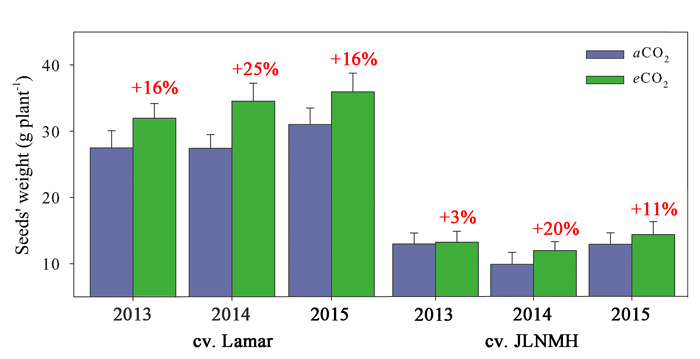| Tweet | Follow @co2science |
Paper Reviewed
Zhang, Y., Dai, Y., Wan, G., Liu, B., Xing, G. and Chen, F. 2018. Effects of elevated CO2 on plant chemistry, growth, yield of resistant soybean, and feeding of a target Lepidoptera pest, Spodoptera litura (Lepidoptera: Noctuidae). Environmental Entomology 47: 848-856.
How plant-insect interactions might change in the future in response to CO2-induced climate change is of growing interest to scientists, including the research team of Zhang et al. (2018).
As their contribution to the subject, the six Chinese researchers grew two soybean cultivars (Lamar and JLNMH) in pots in open-top chambers under ambient (~374 ppm) or elevated (~732 ppm) atmospheric CO2 concentrations for three consecutive growing seasons (2013, 2014 and 2015). Additionally, they reared larvae of a leaf-chewing herbivorous insect (Spodoptera litura) in a controlled-environment setting and fed the larvae with leaves from the two cultivars grown in the two CO2 treatments. One of the soybean cultivars (Lamar) is considered highly resistant to S. litura attack while the other (JLNMH) is considered highly susceptible.
So what effect did elevated CO2 have on the growth, foliar chemistry and yield of the two soybean cultivars, and how did elevated CO2 impact the growth development and fecundity of S. litura?
Results indicated that elevated CO2 stimulated aboveground biomass, foliar sugar content and C/N ratio, leading to soybean seed yield increases of 16-25% in the Lamar cultivar and 3-20% in the JLNMH cultivar (see Figure 1). Additionally, elevated CO2 caused a reduction in foliar nitrogen content of approximately 16% in Lamar and 9% in JLNMH between the R4 and R6 growth stages.
Correlation analyses between foliar chemistry of the soybean leaves grown under ambient and elevated CO2 conditions and the growth indices of S. litura revealed, according to Zhang et al., that "high foliar sugar and low N content, and high foliar C/N ratio [negatively impacted] the growth, development, and fecundity of S. litura." What is more, the authors report that the highly resistant Lamar cultivar not only experienced a better yield performance than the susceptible JLNMH cultivar under elevated CO2, it also demonstrated a "better performance against herbivorous Lepidoptera insect pests." Thus, in the future, farmers who grow the Lamar cultivar might be best able to take advantage of the plant yield-enhancing and pest damage-reducing effects observed here from rising atmospheric CO2.

Figure 1. Seed weight of resistant (cv. Lamar) and susceptible (cv. JLNMH) cultivars of soybean grown under ambient and elevated CO2 in 2013, 2014 and 2015. Adapted from Zhang et al. (2018).




